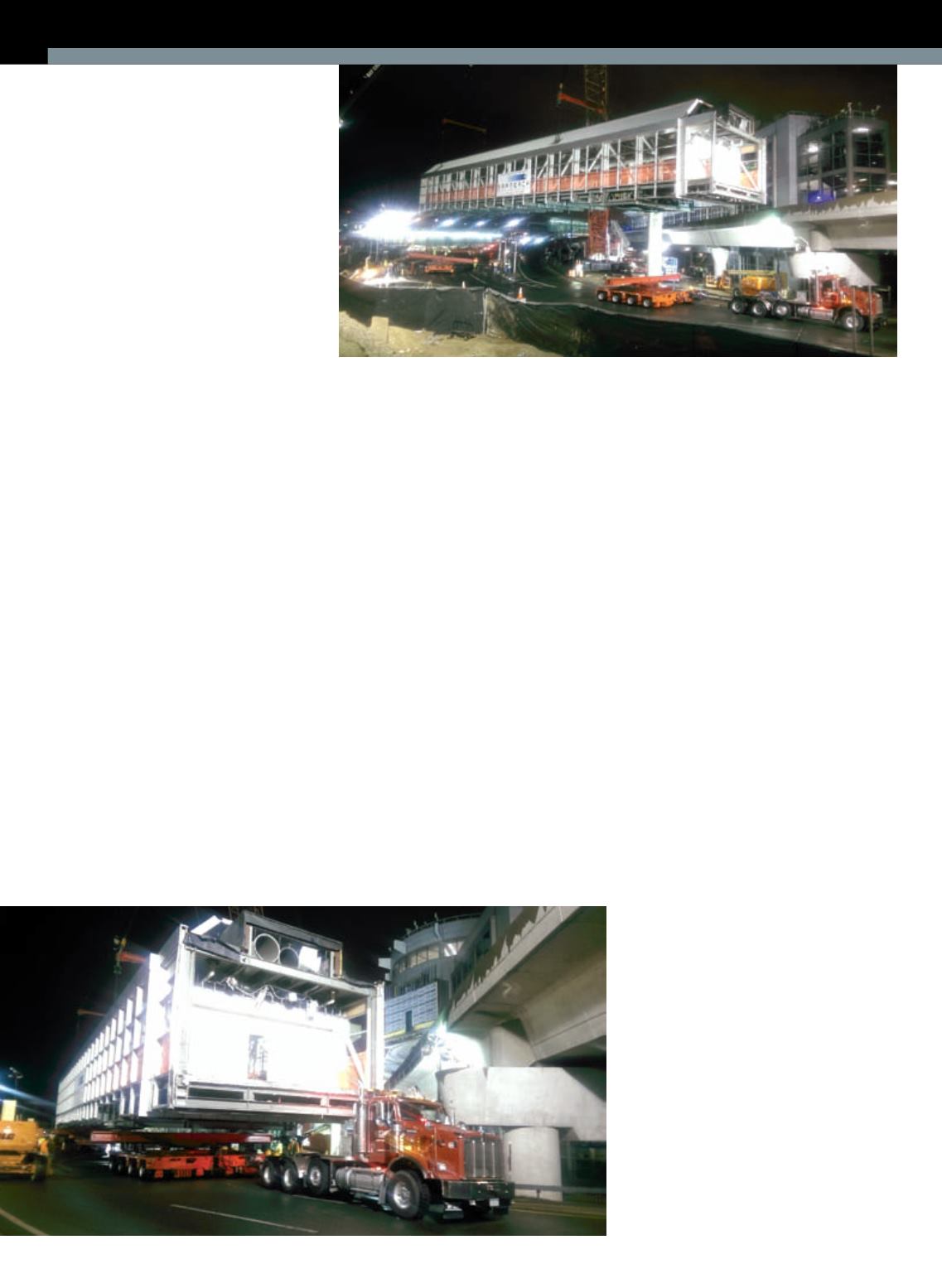
42
ACT
MAY 2014
SITE REPORT
LIFTING& TRANSPORT
was developed and featured a two-crane
lift; landing thebridgeonGoldhofer
transporters; and relocating thebridge
approximately500yards to a roadmore
conducive tobridgedemolition.
To execute the lift, two steel beams
with lifting lugswere secured inside the
bridge structure at offset locations to
precisely imbalance the loadduring lifting
operations consistentwith the eccentric
capabilities of the lifting cranes.
BayCrane then erected aLiebherr
LR-1400-2 crawler craneonone sideof
thebridge. The cranewas riggedwith161
feet ofmainboom, a91-foot derrick, and
thewagon extended to49 feet, allwith full
counterweight.
On theother sideof thebridgeBay
Cranepositioned aLiebherrLTM-1500-
8.1hydraulic cranewith super lift and full
counterweight. Together, at thedynamic
working radius of approximately65 feet,
the two cranes had the capacity to lift
701,600pounds.
Theoffset lifting lugswere critical to
theplan, as they allowed for the eccentric
weight distributionbetween cranes, and
thus allowed the team toutilize the less
robust hydraulic craneonone end.
Concerned about weather
Ultimately, thebridgewouldbe
positioned for demolitionon the same
real estateoccupiedby theLTM-1500
hydraulic craneduring the lift. So, on
landing thebridgeon the transporters,
the teamwas able to rapidlybreakdown
theLTM-1500 and remove it from the
jobsite so that thebridge could thenbe
moved intoposition for demolition, and
thus allowing thequick reopeningof the
busyAirport LoopRoad to traffic and
travelers.
Theweather forecast for the lift night
called for rain andwindgusts up to25
mph. The engineeredplanprohibited
making the liftwithwinds exceeding
11mph.
The shift startedwith a light, but steady
rain andwithwinds surpassing restricted
levels. But the crewworked through the
weather,making all thepreparations
necessary tobe ready as soon as the
weather presented anopportunity to
make the lift.
Theweather did eventually force a
one-hour delay, but the liftwas started
at approximately12:45 a.m., and the
bridgewas safely landed and securedon
the transporters by1:30 a.m. Thebridge
was estimated toweigh480,000pounds,
but during the lift the actualweight
was determined tobe 501,000pounds.
Theweightwas split between the two
craneswith theLR-1400 lifting393,000
pounds and theLTM-1500handling the
remaining108,000pounds.
Thebridgewas landedon an awaiting
pair ofGoldhofer trailers, each equipped
with aGoldhofer 300-tonbolster, and a
pair of 30-foot transport beams to support
thebridge legs.During transport, the
bridge couldonly support itselfwhen
landedon its original bearingplates, thus
requiring theGoldhofer trailer centers
tobe spaced120 feet apart. This spacing
still left thebridge in an eccentric loading
configuration, but thedifferencewas
easily accommodatedby theGoldhofer
trailer arrangement.
“On the lighter end,whichwe estimated
tobe a90-tonbridge load,was a single
wide, 6-axle SPMTwithbolster and
pair of 30-foot,W18by258beamswith
nominal capacityof 180 tons,” said James
F. Radomicki, BayCraneprojectmanager.
“On the anticipatedheavier end,which
we anticipated tobe a160-tonbridge
load,was positionedon adoublewide,
4-axleTHP trailerwithbolster andpair of
30-foot,W14by342beamswithnominal
capacityof 240 tons.”
He said eachGoldhoferwas set
in3-point zoning,was capableof
independent steering, but drivenby
the 6-axle SPMT. After landing and
securing thebridge to thebolster, itwas
transported to the vacateddemolition
area, andoffloadedvia trailer hydraulics
to temporary storage stands for final
disposition.
The liftwas accomplished safely,without
incident, andwithout anyunplanned
interruption to airport operations.
■
The bridge had been estimated toweigh
480,000 pounds, but during the lift the
actual weight was determined to be 501,000
pounds. Theweight was split between the
two craneswith the LR-1400 lifting 393,000
pounds and the LTM-1500 handling the
remaining 108,000 pounds.
The bridgewas landed on an awaiting
pair of Goldhofer trailers, each equipped
with a Goldhofer 300-ton bolster, and
a pair of 30-foot transport beams to
support the bridge legs.


